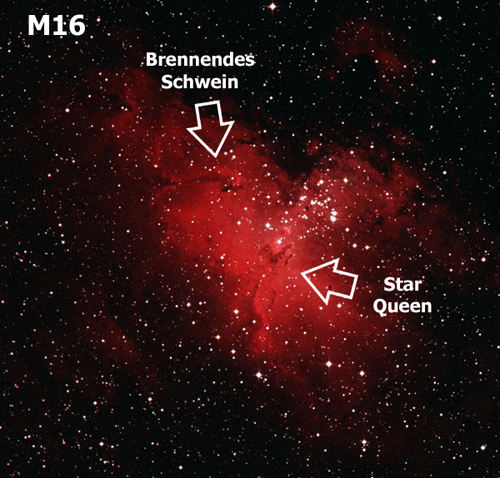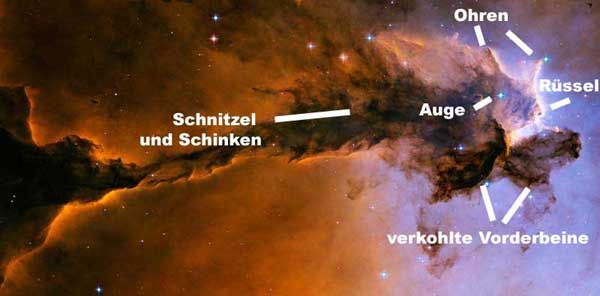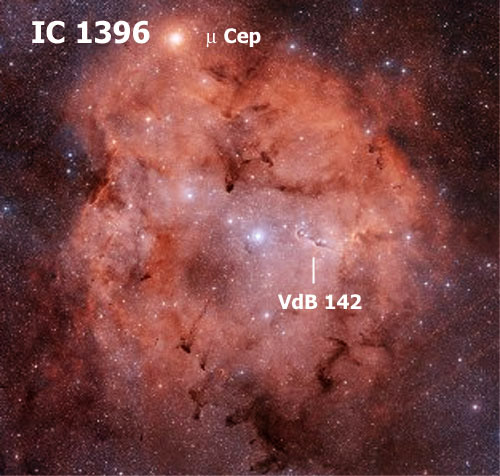
Elephant's Trunk, a Flaming Pig, and a Star Queen
Two dusty summer nebula
June 2007
When I was a little boy, I had a picture of M16 above my bed from a magazine, that was taken with the (at that time) new color composite technique by the Naval Observatory near Flagstaff. I was fascinated by the red HII region and even more by its prominent dark pillars. These dark clouds have been baptized the Pillars of Creation by the STScI publications, referring to the star formation taking place within their obscured interior. Robert Burnham Jr. had referred to these bizarre dark pillars in his Celestial Handbook as the "Star Queen". With my equipment at that time, a 10x50 binocular, I could identify M16, but there was not much else to see.
 |
M 16 with the Star Queen and the Flaming Pig (DSS image) |
These dark structures, which are very prominent on H alpha narrow band images, are surprisingly difficult targets for visual observations, even with telescopes that are substantially larger than my 50mm binoculars from that time. The entire emission nebula around M16 is actually quite weak and becomes conspicuous only with UHC or OIII filters. But even equipped with filter, the dark structures are not prominent and go probably unnoticed by most observers. It takes some time and patience to perceive these small contrasts in brightness and to see the dark pillars stand out in front of the HII region. With my 22" Dob and a transparent sky, I could discern the two southwestern pillars as a long and a short dark band. The third pillar northeast of them was more difficult to discern due to a superimposed bright star.
There is another dark pillar in M16, which had been promoted by pictures of the Hubble Space Telescope and which I named the Flaming Pig. The reason behind this name is obvious from the Hubble image below.
 |
The Flaming Pig on an image of the Hubble Space Telescope (STScI). The most prominent anatomic details are marked in German (their English translations should be obvious from the image). It should be noted, that the space pig has clearly three nostrils, very different from its terrestrial cousins. |
In contrast to the Star Queen, the Flaming Pig is quite a bit more difficult to observe. Even after extended observing with my 22-Inch Dob, I could not make out the flaming of the pig. What I could see was the dark smoke that trails from the forelegs of the pig and that results likely from the supersonic entry of the pig into the denser parts of M16. On the DSS image (at the very top), this smoky trail is evident as the region with the highest contrast to the emission nebula.
Despite their very different appearance, our pigs are distant cousins to the elephants. And this bridges to the Elephant's Trunk, our next observing target. The Elephant's Trunk is in IC 1396, the large HII region in Cepheus, right next to µ Cephei, the Garnet Star.
 |
IC 1396 in Cepheus with the Garnet Star µ Cephei and prominent dark structures, among others the Elephant's Trunk IC 1396a and the superimposed reflections nebula VdB 142 |
The Elephant's Trunk, part of which is also listed as VdB 142 in Sidney Van den Bergh's catalog, is a popular target for astro photographers that want to toy with their new H-alpha emission line filter. For visual observers, VdB 142 and the rest of the elephant's trunk is a rather difficult object. Though it does not require a very large telescope, it does require a lot of patience by the observer. While the big dark wedge in the middle of IC 1396 is relatively easy and stands out prominently, VdB is a hard nut to crack. Only after about half an hour of back and forth sweeping with my 14-Inch Dob, I could make out the southern rim of the dark trunk with certainty and pick it up again reproducibly. Besides patience, a narrow band filter is a requirement (with the UHC being more efficient here than the OIII filter) and the magnification should be not too low.
![]()